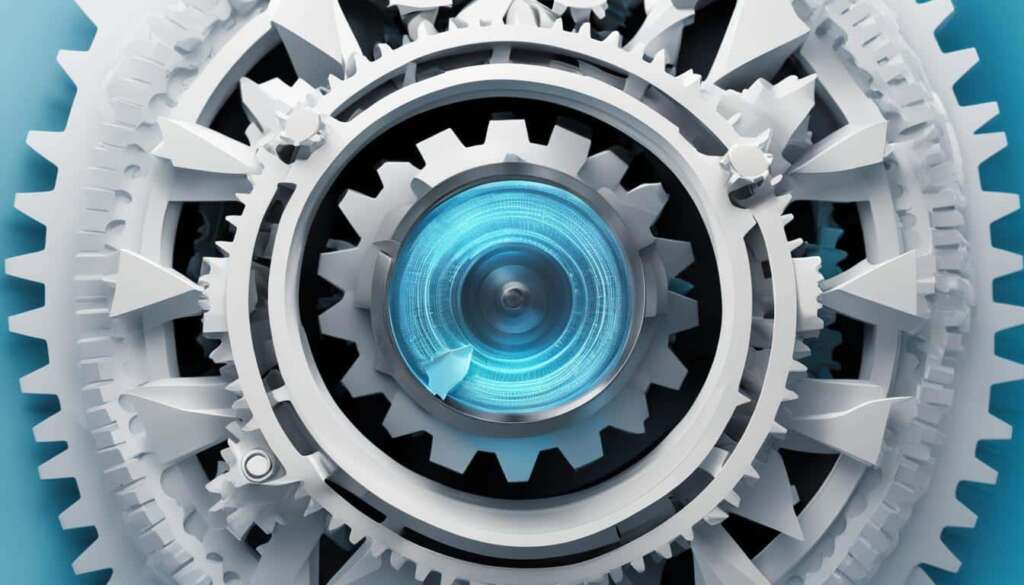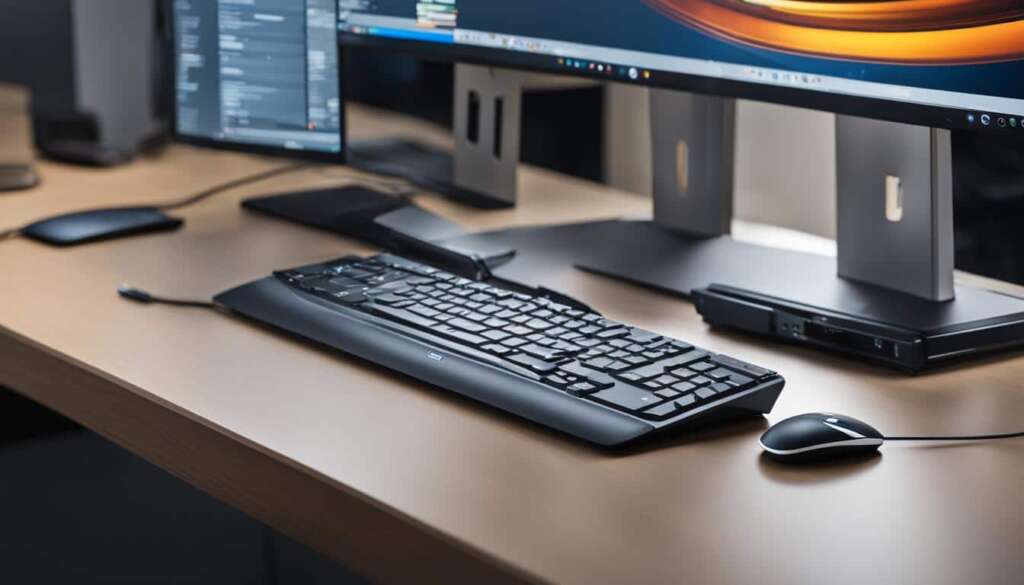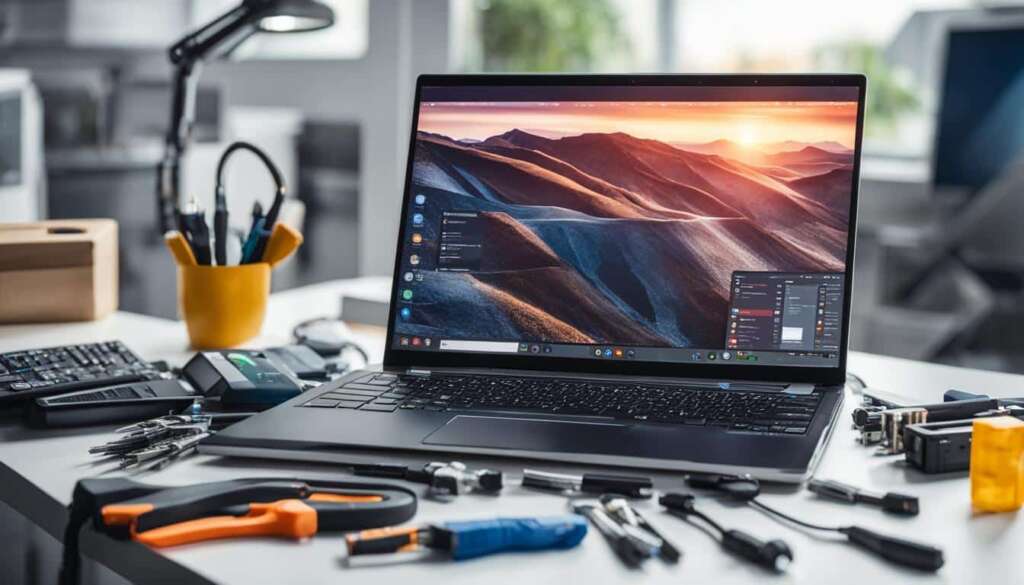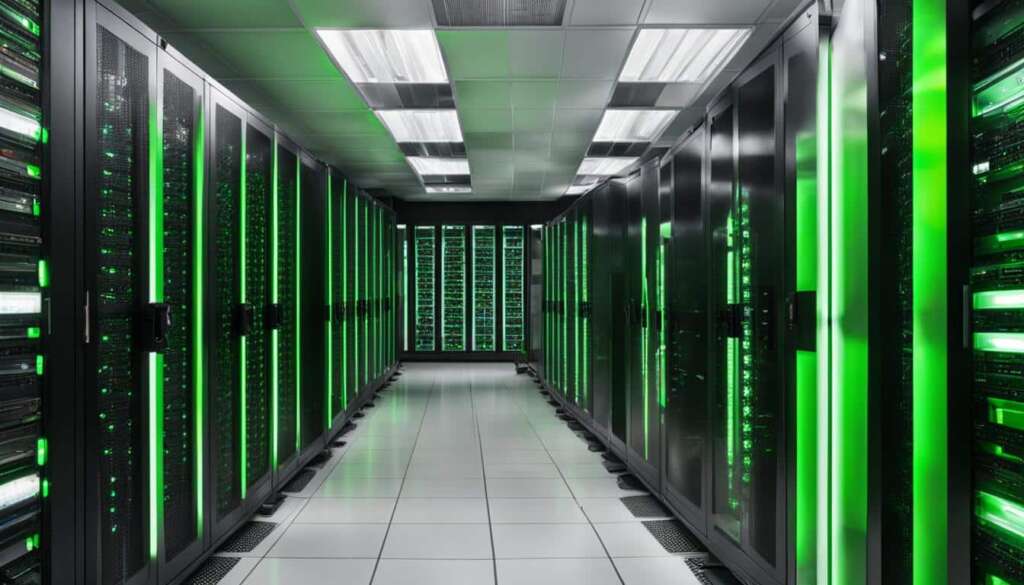Table of Contents
To factory reset your computer, there are several easy steps you can follow. Whether you’re using Windows 10 or Windows 11, the process is mostly the same. First, access the Settings menu by clicking the Start button and selecting the gear icon. Then, navigate to the Update & Security > Recovery section. From there, choose the option to reset your PC and decide whether to keep your files or remove everything. Next, select how you want to reinstall Windows, either from local storage or through a cloud download. Customize additional settings if needed, such as restoring preinstalled apps or securely cleaning your data. Finally, confirm the reset and wait for your computer to restart.
Key Takeaways:
- Factory resetting your computer can help resolve various issues or prepare it for sale or disposal.
- The process of factory resetting is similar for Windows 10 and Windows 11.
- Navigate to the Settings menu and select Update & Security > Recovery to begin the reset.
- Choose to keep your files or remove everything, and select how to reinstall Windows.
- Consider additional data destruction methods for complete data security.
How to Reset Windows 10
Resetting Windows 10 is a straightforward process that can help resolve various issues or prepare your computer for sale or disposal. Here is a step-by-step guide on how to reset your Windows 10 PC:
- Open the Settings window by clicking on the Start menu and selecting the gear icon.
- In the Settings window, go to the Update & Security section.
- Under the Recovery tab, click on the “Get started” button located below the “Reset this PC” option.
- Choose whether to keep your files or remove everything. Select the option that best suits your needs.
- Next, you will be prompted to decide how you want to reinstall Windows. You can either choose to do it locally or through a cloud download.
- Customize additional settings if necessary, such as restoring preinstalled apps or securely cleaning your data.
- Finally, confirm the reset and wait for your computer to restart.
By following these simple steps, you can easily reset your Windows 10 computer and restore it to its factory settings.
Benefits of Resetting Windows 10
Resetting your Windows 10 computer can offer several benefits:
- Fixing software issues: If your computer is experiencing software-related problems or performance issues, a reset can help resolve them.
- Removing malware or viruses: Resetting your PC can eliminate any malicious software that may have infected your system.
- Preparing for resale: If you plan to sell or give away your computer, a factory reset ensures that your personal data is removed.
- Starting fresh: Resetting your computer allows you to start with a clean slate, free from any unwanted programs or settings.
However, it’s important to note that a factory reset will not completely erase the data on your hard drive. If you want to ensure complete data security, consider additional methods of data destruction or consult a professional data destruction company.
How to Reset Windows 11
Resetting Windows 11 is a simple process that you can follow to restore your computer to its factory settings. Whether you want to troubleshoot issues or prepare your device for sale, resetting Windows 11 can help. Here’s a step-by-step guide to resetting Windows 11:
Step 1: Access the Settings Menu
To begin the reset process, you’ll need to access the Settings menu on your computer. Click on the Start button and select the gear icon to open the Settings window.
Step 2: Go to System > Recovery
Once you’re in the Settings menu, navigate to the System tab. From there, click on the Recovery option, which will take you to the recovery settings.
Step 3: Choose the Reset Option
Under the Recovery settings, you’ll find the option to reset your PC. Click on the “Reset PC” button to proceed with the reset process.
Step 4: Select Your Reset Preferences
When you choose to reset your PC, you’ll be given options to keep your personal files or remove everything. Select the option that suits your needs. Additionally, you can decide whether to reinstall Windows from local storage or through a cloud download.
Step 5: Customize Additional Settings
If necessary, you can customize additional settings during the reset process. This includes restoring preinstalled apps or securely cleaning your data. Adjust these settings according to your preferences.
Step 6: Confirm the Reset
Once you’ve made all the necessary selections, confirm the reset by clicking on the “Reset” button. Your computer will then initiate the reset process and restart.
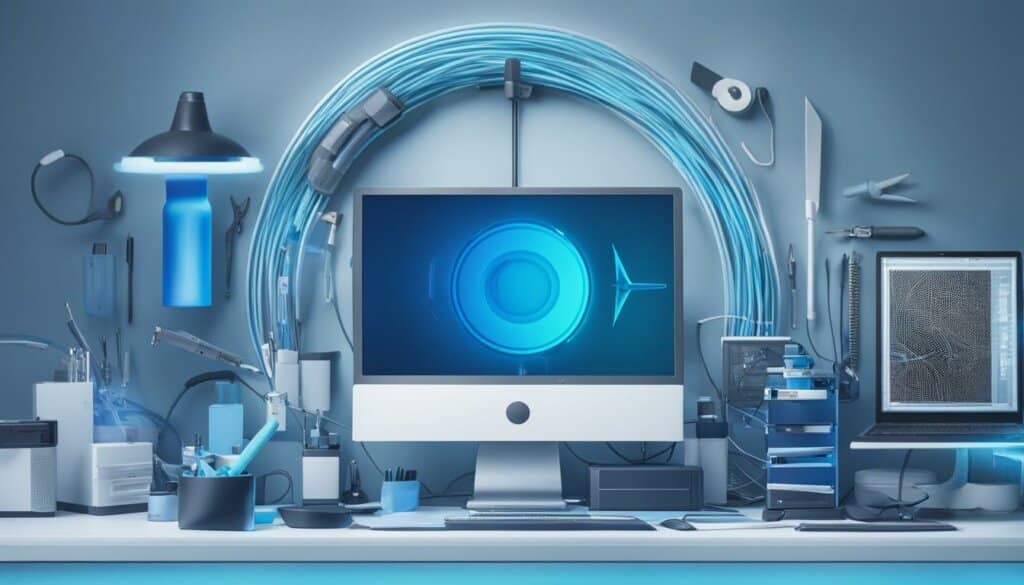
| Pros of Resetting Windows 11 | Cons of Resetting Windows 11 |
|---|---|
|
|
Remember to back up your important files before resetting your computer. This will ensure that you don’t lose any valuable data during the process.
By following these steps, you can easily reset your Windows 11 computer and restore it to its original factory settings. Always make sure to back up your data and carefully consider the implications of resetting before proceeding.
What is a Factory Reset?
A factory reset is a process that restores your computer to its original state, similar to how it was when it first came out of the factory. It removes any additional programs or files that were added after the initial production. This can be useful if your computer is experiencing issues or if you plan to sell or dispose of it. However, it’s important to note that a factory reset does not completely erase the data on your hard drive. It only removes the software and settings, while the data still remains on the drive.
When you perform a factory reset, your computer is essentially wiped clean of any personalization or customization that was done since its purchase. All installed software, including apps and programs, is removed, and the operating system is restored to its original configuration. This can be beneficial if you want a fresh start with your computer or if you’re experiencing significant performance issues.
It’s important to understand that a factory reset does not remove any physical data from your hard drive. The data is still present on the drive; it’s just not accessible through normal operations. If you’re selling or disposing of your computer, it’s essential to take additional steps to ensure that your data is securely erased. Data forensics tools can potentially recover data even after a factory reset, so if you want to ensure complete data security, it’s recommended to use more advanced methods of data destruction, such as degaussing or physically destroying the hard drive.
| Pros | Cons |
|---|---|
|
|
Why a Reset Sometimes Isn’t Enough
A factory reset can be an effective solution for many Windows issues, but it’s important to understand its limitations. While a factory reset restores your computer to its original state, it may not completely erase your data. When you perform a factory reset, the information is hidden from the computer but can still be recovered using data forensics tools. This means that if you’re selling or disposing of your computer, it’s crucial to take additional steps to ensure the complete destruction of your data.
One reason a factory reset may not be enough to protect your data is that it doesn’t completely erase the contents of your hard drive. It only removes the software and settings, while the data still remains on the drive. This means that even though your computer appears to be reset, someone with the right tools and knowledge could potentially retrieve your personal information.
For individuals or organizations with sensitive data, such as financial or personal records, it’s essential to use more intensive data destruction methods. These methods ensure that your data is completely and irreversibly destroyed, leaving no trace behind. Examples of such methods include degaussing, which erases data by altering the magnetic fields on a hard drive, or physically destroying the hard drive itself.
It’s also important to note that solid-state drives (SSDs) require different data destruction methods compared to traditional hard drives. SSDs use flash memory to store data, which means they don’t have magnetic storage. Therefore, techniques like degaussing won’t work on them. To securely erase data from an SSD, specialized software or hardware-based solutions are needed.
In summary, while a factory reset can be a convenient solution for many Windows issues, it may not provide sufficient data security. To ensure complete data destruction, more intensive methods such as degaussing or physically destroying the hard drive may be necessary. It’s crucial to take these extra steps when selling or disposing of your computer to protect your personal information and prevent it from falling into the wrong hands.
How to Securely Dispose of Your Computer
Properly disposing of your computer is crucial to protect your personal data and minimize environmental impact. Follow these steps to securely recycle your computer and ensure your information stays safe.
Step 1: Back Up Your Data
Prior to recycling your computer, it’s essential to back up any important files or data you want to keep. Transfer your files to an external hard drive, a cloud storage service, or another computer to ensure they are safely preserved.
Step 2: Perform a Data Wipe
Next, perform a thorough data wipe to remove all personal information from your computer’s hard drive. This step is crucial to protect your privacy and prevent any potential data breaches. There are several software programs available that can securely erase your data, ensuring it cannot be recovered. Follow the instructions provided by the software to complete the data wipe process.
Step 3: Find a Certified Electronics Recycler
When it comes to recycling your computer, it’s important to choose a certified electronics recycler. These organizations specialize in the proper disposal of electronic waste and adhere to strict environmental and data security standards. Look for recycling facilities that are certified by organizations like e-Stewards or R2 (Responsible Recycling) to ensure your computer is recycled responsibly.
| Benefits of Using a Certified Electronics Recycler | Proper Data Destruction | Environmental Responsibility |
|---|---|---|
| Certified electronics recyclers have the expertise to ensure your personal data is securely destroyed during the recycling process. | By recycling your computer through a certified recycler, you are preventing it from ending up in landfills and contributing to electronic waste pollution. | Certified recyclers follow environmentally responsible practices, maximizing recycling and minimizing harm to the environment. |
| Recyclers are audited to ensure compliance with data protection laws and regulations, giving you peace of mind that your data will not be compromised. | The recycling process involves recovering valuable materials, such as metals and plastics, that can be reused in the production of new products. | Choosing a certified recycler aligns with your commitment to sustainable practices and helps protect the planet. |
Step 4: Drop Off or Schedule a Pickup
Once you have identified a certified electronics recycler, you can drop off your computer at their designated collection point or schedule a pickup if available. Some recyclers offer convenient drop-off locations, while others provide pickup services for larger items. Follow the instructions provided by the recycler to ensure a smooth and hassle-free recycling process.
Remember, responsibly disposing of your computer is not only crucial for data security but also for the health of the environment. By following these steps and choosing a certified electronics recycler, you can ensure your computer is recycled in a safe and sustainable manner.
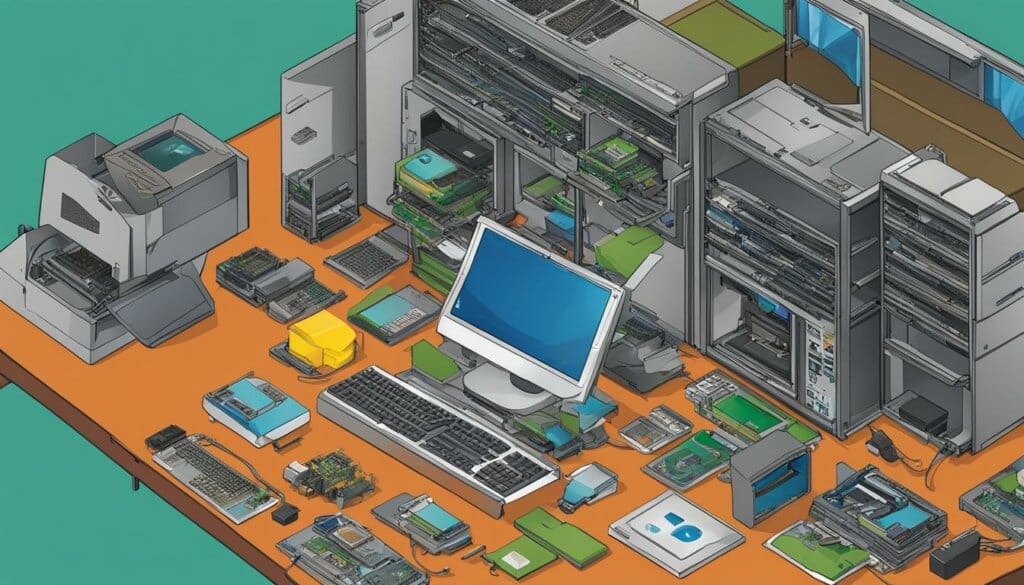
Conclusion
Factory resetting your computer can be a useful solution for various issues or when preparing to sell or dispose of your machine. By following the easy steps outlined in this guide, you can successfully perform a factory reset on your Windows 10 or Windows 11 computer. Remember to back up your important files before proceeding and consider additional data destruction methods if you want to ensure complete data security. Properly disposing of your computer and recycling electronic waste is also important for the environment.
Performing a factory reset on your computer is a straightforward process that can help resolve problems and restore your device to its original state. Whether you’re using Windows 10 or Windows 11, the steps are similar and easy to follow. Just access the Settings menu, navigate to the appropriate section, choose the reset option, customize settings if necessary, and confirm the reset. Your computer will then restart and be ready to use.
However, it’s essential to remember that a factory reset does not completely erase the data on your hard drive. To ensure complete data destruction, more intensive methods such as degaussing or physically destroying the hard drive may be necessary, especially if you’re planning to sell or dispose of your computer. Additionally, solid-state drives (SSDs) require different data destruction methods due to their unique storage technology.
Before recycling or selling your computer, it’s crucial to properly secure and dispose of your data. Ensure you perform a thorough data wipe to erase all personal information from the hard drive. Professional data destruction companies can assist you in this process and provide comprehensive data security. Also, remember to recycle electronic waste responsibly to minimize environmental harm. Find local recycling facilities that specialize in electronic waste disposal through dedicated organizations like eStewards.
FAQ
How do I factory reset my computer?
To factory reset your computer, access the Settings menu, go to the Update & Security > Recovery section, select the option to reset your PC, choose whether to keep your files or remove everything, decide how you want to reinstall Windows, customize additional settings if needed, and confirm the reset.
How do I reset Windows 10?
To reset Windows 10, open the Settings window, go to the Update & Security > Recovery section, select the option to reset your PC, choose whether to keep your files or remove everything, decide how you want to reinstall Windows, customize additional settings if necessary, and confirm the reset.
How do I reset Windows 11?
To reset Windows 11, access the Settings menu, go to System > Recovery, click on the option to reset your PC, choose whether to keep your files or remove everything, decide how you want to reinstall Windows, customize additional settings if needed, and confirm the reset.
What is a factory reset?
A factory reset restores your computer to its original state, similar to how it was when it first came out of the factory. It removes any additional programs or files that were added after the initial production.
Why isn’t a reset always enough?
While a factory reset can be a convenient solution for many issues, it may not completely erase your data. Additional methods such as degaussing or physically destroying the hard drive may be necessary to ensure complete data destruction.
How do I securely dispose of my computer?
Before recycling or selling your computer, perform a thorough data wipe to securely erase all personal information from the hard drive. You can hire professional data destruction companies or find local recycling facilities for electronic waste.
How do I ensure complete data security?
To ensure complete data security, consider backing up your important files before performing a factory reset and use additional data destruction methods if necessary. Properly disposing of your computer and recycling electronic waste is also important for the environment.

